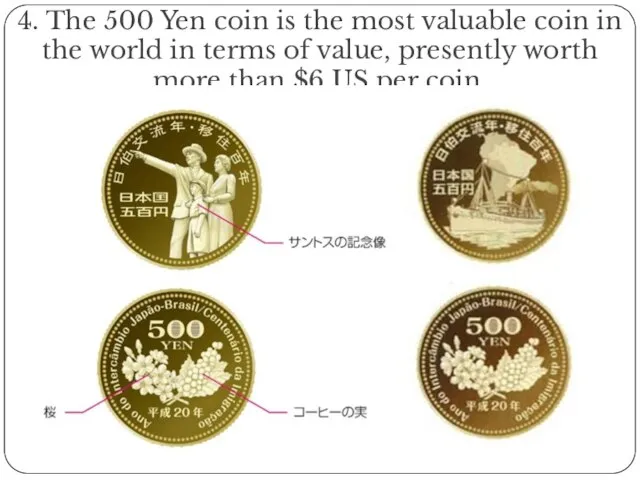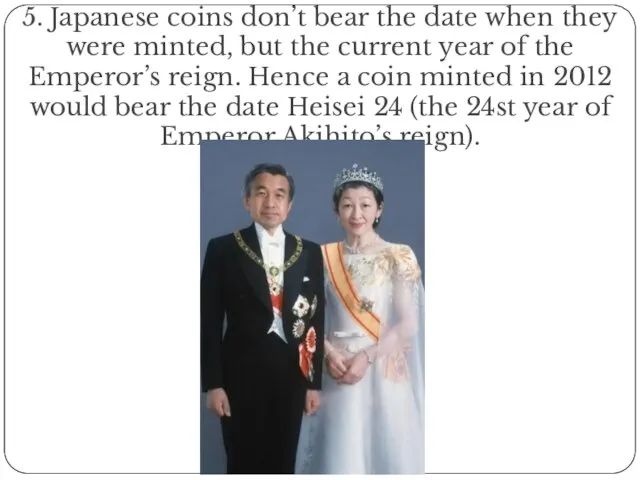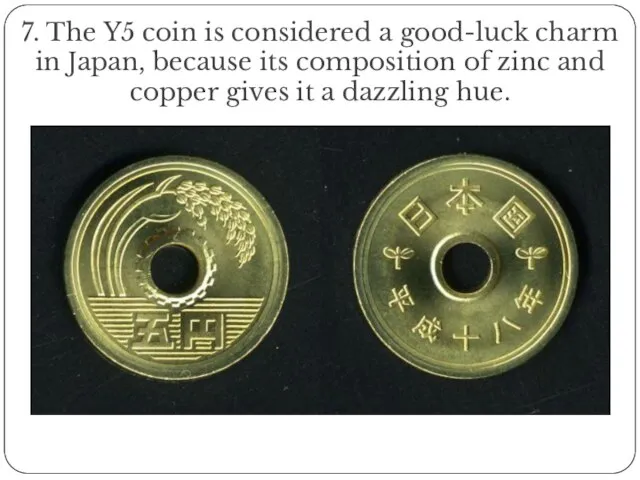Слайд 2Plan of the presentation
History of the Japanese yen.
Some photos of Japanese money.
Interesting

facts about the Japanise yen.
Слайд 3History of the Japanese yen.
In the 19th century silver Spanish dollar coins

were common throughout Southeast Asia, the China coast, and Japan. These coins had been introduced through Manila over a period of two hundred and fifty years, arriving on ships from Acapulco in Mexico.
Слайд 4The yen was officially adopted by the Meiji government in an Act

signed on May 10, 1871. The new currency was gradually introduced beginning from July of that year. The yen was therefore basically a dollar unit, like all dollars, descended from the Spanish Pieces of eight, and up until the year 1873, all the dollars in the world had more or less the same value.
Слайд 5The yen lost most of its value during and after World War

II. After a period of instability, in 1949, the value of the yen was fixed at ¥360 per US$1 through a United States plan, which was part of the Bretton Woods System, to stabilize prices in the Japanese economy.
Despite intervention, market pressures caused the yen to continue climbing in value, peaking temporarily at an average of ¥271 per US$1 in 1973 before the impact of the 1973 oil crisis was felt. The increased costs of imported oil caused the yen to depreciate to a range of ¥290 to ¥300 between 1974 and 1976. The re-emergence of trade surpluses drove the yen back up to ¥211 in 1978. This currency strengthening was again reversed by the second oil shock in 1979, with the yen dropping to ¥227 by 1980.
Слайд 6After declining somewhat in 1989 and 1990, it reached a new high

of ¥123 to US$1 in December 1992. In April 1995, the yen hit a peak of under 80 yen per dollar, temporarily making Japan's economy nearly the size of the US.
On April 4, 2013 the Bank of Japan announced that they would expand their Asset Purchase Program by $1.4t USD in two years. The Bank of Japan aims hopes to bring Japan from deflation to inflation, aiming for 2% inflation. The amount of purchases is so large that it is expected to double the money supply.
Слайд 7Some photos of Japanese money.

Слайд 10Interesting facts about the Japanise yen:
1. The word “Yen” means “round object”

in Japanese. The world comes from the Spanish dollars (coins) that were introduced to Japan in the 18th century.
Слайд 112. The Japanese pronounce “Yen” as “En.” The difference between this and

the English comes from the widely-distributed Japanese-to-English dictionary of Walter Henry Medhurst, who made a mistake, and in fact hadn’t been to Japan when he wrote his dictionary in the 18th century!
Слайд 123 .The 1 Yen coin is made from 100% aluminium, and can

float.
Слайд 134. The 500 Yen coin is the most valuable coin in the

world in terms of value, presently worth more than $6 US per coin.
Слайд 145. Japanese coins don’t bear the date when they were minted, but

the current year of the Emperor’s reign. Hence a coin minted in 2012 would bear the date Heisei 24 (the 24st year of Emperor Akihito’s reign).
Слайд 156. The Y5 and Y50 coins have holes in the centre. This

makes them more difficult to counterfeit.
Слайд 167. The Y5 coin is considered a good-luck charm in Japan, because

its composition of zinc and copper gives it a dazzling hue.















 Read about some of the hottest scandals of Hollywood and try to identify passive voice
Read about some of the hottest scandals of Hollywood and try to identify passive voice I know my ABC
I know my ABC Invite
Invite To be
To be Читалка. Приложение к фонетическому курсу Честный английский
Читалка. Приложение к фонетическому курсу Честный английский Birthday conversation activities
Birthday conversation activities Job hunting dialogue
Job hunting dialogue Машинный перевод
Машинный перевод My Favorite destination. Altai
My Favorite destination. Altai Check your vocabulary. Quiz
Check your vocabulary. Quiz My teddy bear has got
My teddy bear has got Spotlight 2 My Animals
Spotlight 2 My Animals School and education
School and education Flying cars
Flying cars Vermont. Population characteristics
Vermont. Population characteristics Jack & the Beanstalk
Jack & the Beanstalk Сходства и различия суеверий пилотов России и Великобритании
Сходства и различия суеверий пилотов России и Великобритании Answer the questions
Answer the questions Body parts (lesson 5)
Body parts (lesson 5) Most interesting
Most interesting Hamster
Hamster The business culture of Japan
The business culture of Japan Blue helicopter
Blue helicopter Conditionals: zero and first
Conditionals: zero and first Present Continuous-for school programme
Present Continuous-for school programme Стихи для фонетической зарядки по английскому языку
Стихи для фонетической зарядки по английскому языку Aucun titre de diapositive
Aucun titre de diapositive Relative clauses pro english super mario
Relative clauses pro english super mario